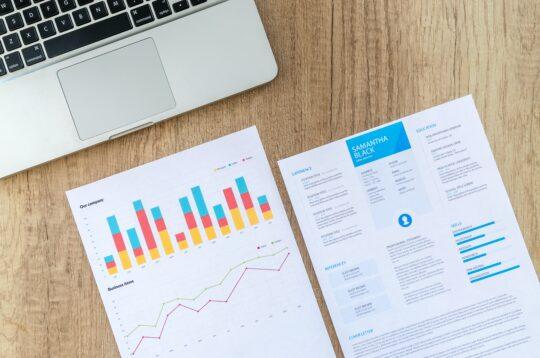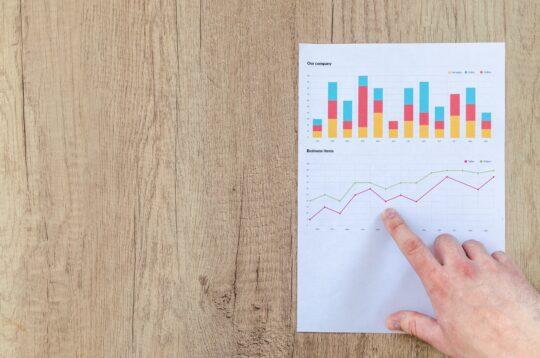Understanding the HR Dashboard
The HR dashboard enables you to make decisions that will have a positive impact on the company, thanks to HR KPIs.
As HR managers increasingly need to focus on their department’s return on investment (ROI), the HR dashboard enables them to manage and measure the actions of the human resources department, helping them to make the right decisions.
The HR dashboard is therefore a real-time management and measurement tool. It provides a visual summary of the activities and results of the human resources department. The tables and graphs generated are based on qualitative and quantitative performance indicators, selected in advance according to the company’s specific requirements (turnover, absenteeism, eNPS, etc.).
The HR dashboard can also be used to set objectives and monitor progress on a regular basis.
Measuring HR Performance with the Dashboard
Selection of key performance indicators (KPIs)
There are a multitude of key performance indicators. To help you find your way around and build an effective dashboard, we’ve listed these indicators by category. Here are the most common HR KPIs, to be selected according to your business.

Recruitment indicators
Recruitment is a strategic issue for companies. Recruiting can be costly, and poor recruitment just as much, if not more. That’s why we need to keep a close eye on the related indicators, both to improve the recruitment process and to keep costs under control.
- Number of recruitments over a defined period
- Average time to hire
- Job offer acceptance rate
- Recruitment costs
- Retention rate
- Recruitment satisfaction (evaluation of the candidate experience)
- Onboarding satisfaction rate
- Number of trainees hired
Internal mobility indicators
Internal mobility is essential if the company is to have the skills it needs in the right place. It’s a quicker, cheaper alternative to external recruitment. Good KPIs on internal mobility show that the company offers its employees opportunities for advancement. Internal mobility is an important lever for loyalty and retention.
- Internal mobility rate
- Promotion rates
- Horizontal mobility rate
- Geographical mobility rate
Performance monitoring indicators
Employee performance appraisals enable us to monitor the achievement of global and individual objectives, and to take adjustment or optimization measures if necessary.
- Number of individual interviews per year
- Average percentage achievement of individual objectives
- Employee satisfaction
- Turnover rate
- Sales per employee
- Employee productivity rate
Skills and training management indicators
Tracking indicators linked to skills and training management is an opportunity to build your GPEC (forward-looking management of jobs and skills) and thus better manage your payroll.
- Rate of development plans implemented
- Cost of training per employee
- Training time per employee
- Percentage of employees having attended at least one training course
- Average training satisfaction score
- Using the merit review
Social climate indicators
The
social climate measurement
is essential to ensure that employees feel at home in the organization and are productive. The key KPIs for measuring the social climate are :
- Employee Net Promoter Score (eNPS)
- Evolution of satisfaction and commitment
- Employee turnover and retention rates
- The turnover rate of new employees
- Overall absenteeism rate
- Absenteeism rate by manager or department
HR socio-demographic indicators
Socio-demographic indicators enable us to anticipate retirements, prepare for the replacement of an employee, and improve parity and equality between men and women.
- Average salary (overall and by profession/hierarchical level)
- Breakdown of employees by gender and socio-professional category
- Number of employees by type of contract
- Average seniority
- The age pyramid
- Absenteeism rates by department / age
Compensation and benefits indicators
Management pays particular attention to compensation and incentive indicators. They place the HR department at the heart of the company’s financial strategy.
- Levels of loaded and unloaded payroll
- Average rate of increase by category (excluding promotions)
- Average rate of increase in promotions
- Total cost of departures (legal and transactional indemnities, litigation costs, etc.)
- Identification of special contractual clauses (parachute, guaranteed bonuses, non-competition)
- Financial equilibrium of social programs (healthcare, welfare, retirement),
- other …) and a description of the level of coverage
- Employee savings data (average profit-sharing, average participation, average matching contribution, average voluntary payment, average portfolio level by site)
How to monitor and interpret these KPIs with the HR dashboard
Once you’ve selected your key HR indicators, you can structure the dashboard according to the nature of the indicators you decide to insert. We can therefore imagine different types of dashboard with different purposes: HR social dashboard, HR financial dashboard, HR forecast dashboard, professional risk management dashboard…

Managing HR with the Dashboard
The dashboard provides a quick and concise overview of human resources efficiency. It highlights the organization’s strengths as well as its shortcomings. In a predictive way, the HR dashboard can even anticipate potential sticking points (e.g. mass retirements), enabling corrective action to be taken (e.g. recruitment or internal mobility).
Thanks to numerical data, HR can carry out precise analyses. The HR dashboard thus becomes a genuine decision-making tool.
The issues surrounding the HR dashboard are organizational, social, economic and strategic. The cost of each action is known and controlled, making it possible to keep expenses under control.
Ultimately, the HR dashboard sheds light on the impact of HR strategy on the company’s performance and health, as it enables us to :
- check that objectives have been met,
- valorize the results obtained,
- optimize organization,
- manage and control HR costs.
Examples of decisions made using the HR dashboard
Based on the indicators selected, HR will be able to analyze the payroll and make decisions.
Using the turnover rateHR can analyze the company’s health.
Is turnover a problem (i.e. the company has not anticipated departures) or a matter of choice (i.e. retirement, end of contract)? To identify the nature of turnover, HR can then look at other indicators or set up surveys.
Visit absenteeism rate allows you to analyze the reasons for stoppages, average downtime and implement corrective actions. Are working conditions the cause of work stoppages? Why are employees absent? Is it demotivation? The correlation between turnover and absenteeism is often instructive. We can, for example, correlate absences with departures, and then take the necessary decisions.
The KPI of the age pyramid and seniority allows us to anticipate departures and take measures to support them. Some companies, for example, support the change of life upon retirement. This contributes to our employer brand. We also need to anticipate the transfer of knowledge and know-how, to avoid employees leaving the company without a transfer. All this is easy to anticipate and manage thanks to the HR dashboard.
Monitor compensation indicators (salaries and incentive schemes) also allows us to step back and consider the potential correlation between salary and commitment: does the level of remuneration have an influence on absenteeism? Do bonuses help retain employees? The aim is to look at what has been put in place within the company and the impact of these actions, so that new measures can be taken if necessary.
Create an effective HR Dashboard
Key steps in creating an HR dashboard
To create a useful HR dashboard for your company, you must first ask yourself what your company’s needs and concerns are: what information do I need to effectively manage HR?
Next, you need to define your objectives and know what kind of decisions you’ll have to make based on the data you’ve gathered from the dashboard.
Finally, you can select the relevant key performance indicators (KPIs) to build your HR dashboard. Don’t try to track every indicator. Select the most relevant ones for an effective dashboard. We recommend aggregating between 5 and 10 indicators maximum to guarantee the effectiveness of the dashboard. The dashboard must remain concise.
From the outset, set the frequency of table updates. This includes updating data, as well as adding or deleting KPIs, according to your needs. Keeping dashboard data up to date can be time-consuming and counter-productive. We therefore recommend that you automate data recovery whenever possible.
Check data availability upstream: where is it located? Are they easily recoverable? If you have an HRIS (Human Resources Management Information System) or an ERP management and administration module, data will be more easily accessible. However, some more subjective or qualitative data will be more difficult to aggregate. Particular attention must be paid to the reliability of data: erroneous data will lead to bad decisions.
Useful software and tools for creating an HR dashboard
You can either create your own dashboard in Excel, or use a dedicated dashboard software package. The most important thing is that this dashboard is useful to the company and easy to use for the employees who will be using it. Focus on visuals and data visualization: an effective dashboard can be read at a glance, on a single page.
At Boost’RH, we recommend automating dashboards as much as possible, and preferring to use software. Our HR consultants can help you set it up and keep it up to date. This leaves you more time for analysis and decision-making.
Tips for maintaining and updating your HR dashboard
Keeping the dashboard up to date is the key to unlocking its full potential and making informed decisions. Here are our tips for keeping your dashboard up to date over the long term:
- select a limited number of KPIs (between 5 and 10);
- check data reliability upstream;
- automate data recovery as far as possible to avoid errors during updates;
- ensure that every employee who uses the tool is familiar with it, and don’t hesitate to train employees on the subject;
- regularly check the relevance of indicators and, if necessary, delete / add a new indicator.
Too many companies don’t track their KPIs and don’t have dashboards. As we have seen, the dashboard is a formidable tool for decision-making and improving overall company performance. Don’t hesitate to call on an external HR consultant to set up an HR dashboard within your company. With his experience, he will be able to guide you in the selection of relevant indicators, and suggest a suitable digital tool to create an effective table, facilitating analysis and decision-making.


